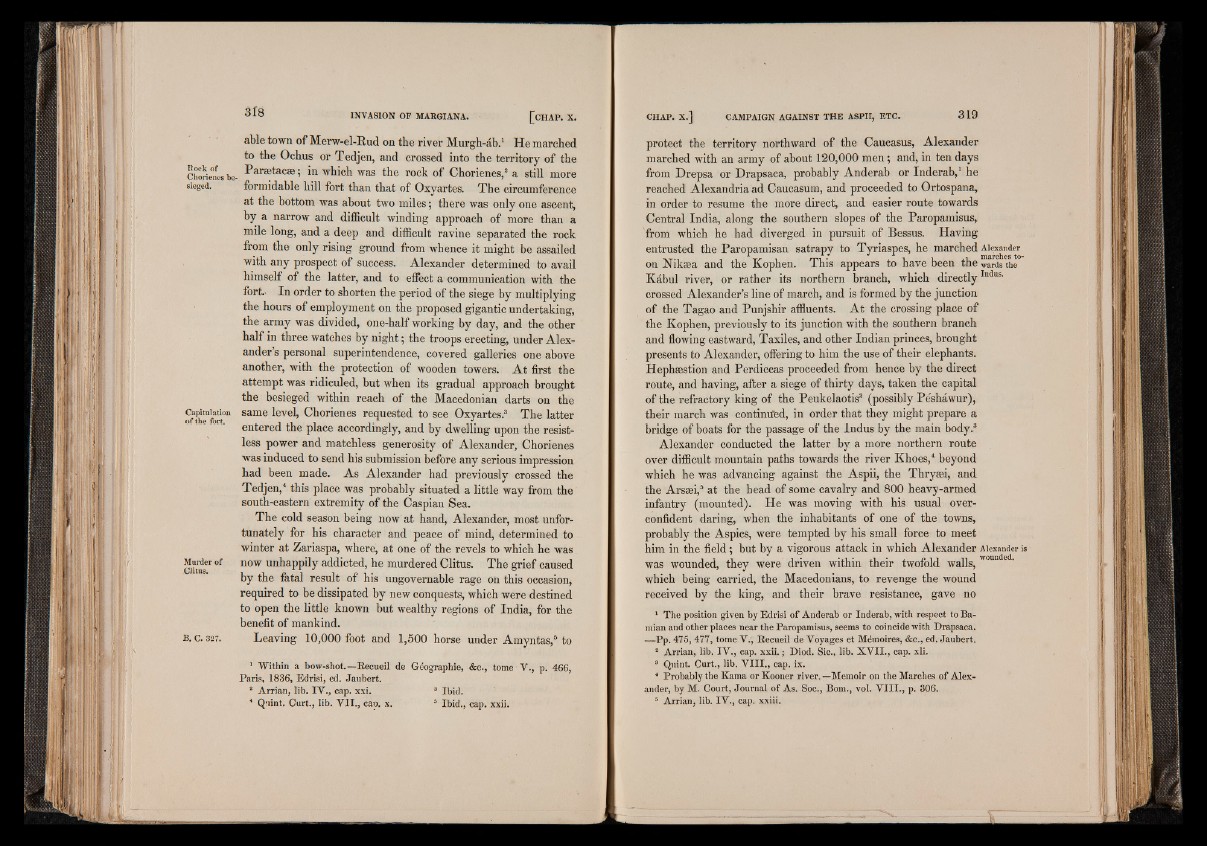
Rock of
Chorienes besieged.
Capitulation
of the fort.
Murder of
Ciitus.
B. C. 327.
able town of Merw-el-B,ud on the river Murgh-ab.1 He marched
to the Ochus or Tedjen, and crossed into the territory of the
Paraetacae; in which was the rock of Chorienes,8 a still more
formidable hill fort than that of Oxyartes. The circumference
at the bottom was about two miles; there was only one ascent,
by a narrow and difficult winding approach of more than a
mile long, and a deep and difficult ravine separated the rock
from the only rising ground from whence it might be assailed
with any prospect of success. Alexander determined to avail
himself of the latter, and to effect a communication with the
fort.. In order to shorten the period of the siege by multiplying
the hours of employment on the proposed gigantic undertaking,
the army was divided, one-half working by day, and the other
half in three watches by night; the troops erecting, under Alexander’s
personal superintendence, covered galleries one above
another, with the protection of wooden towers. At first the
attempt was ridiculed, but when its gradual approach brought
the besieged within reach of the Macedonian darts on the
same level, Chorienes requested to see Oxyartes.3 The latter
entered the place accordingly, and by dwelling upon the resistless
power and matchless generosity of Alexander, Chorienes
was induced to send his submission before any serious impression
had been made. As Alexander had previously crossed the
Tedjen,4 this place was probably situated a little way from the
south-eastern extremity of the Caspian Sea.
The cold season being now at hand, Alexander, most unfortunately
for his character and peace of mind, determined to
winter at Zariaspa, where, at one of the revels to which he was
now unhappily addicted, he murdered Ciitus. The grief caused
by the fatal result of his ungovernable rage on this occasion,
required to be dissipated by new conquests, which were destined
to open the little known but wealthy regions of India, for the
benefit of mankind.
Leaving 10,000 foot and 1,500 horse under Amyntas,5 to
1 Within a bow-shot.—Eecueil de Geographie, &c., tome V., p. 466,
Paris, 1836, Edrisi, ed. Jaubert.
8 Arrian, lib. IV ., cap. xxi. 3 Ibid.
* Qnint. Curt., lib. V I I ., cap. x. 3 Ibid., cap. xxii.
protect the territory northward of the Caucasus, Alexander
marched with an army of about 120,000 men ; and, in ten days
from Drepsa or Drapsaca, probably Anderab or Inderab,1 he
reached Alexandria ad Caucasum, and proceeded to Ortospana,
in order to resume the more direct, and easier route towards
Central India, along the southern slopes of the Paropamisus,
from which he had diverged in pursuit of Bessus. Having
entrusted the Paropamisan satrapy to Tyriaspes, he marched Alexander^
on Nikæa and the Kophen. This appears to have been the wards the
Kabul river, or rather its northern branch, which directlyIndns'
crossed Alexander’s line of march, and is formed by the junction
of the Tagao and Punjshir affluents. At the crossing place of
the Kophen, previously to its junction with the southern branch
and flowing eastward, Taxiles, and other Indian princes, brought
presents to Alexander, offering to him the use of their elephants.
Hephæstion and Perdiccas proceeded from hence by the direct
route, and having, after a siege of thirty days, taken the capital
of the refractory king of the Peukelaotis2 (possibly Péshâwur),
their march was contimfed, in order that they might prepare a
bridge of boats for the passage of the Indus by the main body.3
Alexander conducted the latter by a more northern route
over difficult mountain paths towards the river Khoes,4 beyond
which he was advancing against the Aspii, the Thryæi, and
the Arsæi,5 at the head of some cavalry and 800 heavy-armed
infantry (mounted). He was moving with his usual overconfident
daring, when the inhabitants of one of the towns,
probably the Aspics, were tempted by his small force to meet
him in the field ; but by a vigorous attack in which Alexander Alexander is
was wounded, they were driven within their twofold walls,
which being carried, the Macedonians, to revenge the wound
received by the king, and their brave resistance, gave no
* The position given by Edrisi of Anderab or Inderab, with respect to Ba-
mian and other places near the Paropamisus, seems to coincide with Drapsaca.
—Pp. 475,477, tome V., Recueil de Voyages et Mémoires, &c., ed. Jaubert.
8 Arrian, lib. IV ., cap. xxii. ; Diod. Sic., lib. X V I I ., cap. xli.
8 Quint. Curt., lib. V I I I ., cap. ix.
* Probably the Kama or Kooner river. —Memoir on the Marches o f Alexander,
by M. Court, Journal of As. Soc., Bom., vol. V I I I ., p. 306.
5 Arrian, lib. IV., cap. xxiii.